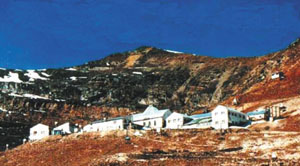
New support for the Chacaltaya Cosmic Ray Research Laboratory, on Mount Chacaltaya near La Paz, Bolivia, underlines its relevance for cosmic ray research. At 5220 m above sea level (a barometric pressure of about 540 mbar; just over 0.5 atm), it is the highest continuously functioning research station on the globe, providing a unique opportunity for siting relatively large cosmic ray detectors.
At energies above 1014 eV, the flux of primary cosmic rays is so low that direct observation by balloon- or satellite-borne instruments (with areas of only a few square metres) is difficult. For example, the integral primary cosmic ray flux of energies above 1016 eV is only one particle per m2 per year. Consequently the most sensitive indirect studies of cosmic rays with energies of 1015 eV (1 PeV) and above suggest the deployment of large-area detector systems at as high a terrestrial elevation as possible, in order to reduce atmospheric shielding.
Although Brazilian and Japanese groups have maintained their research activities at Chacaltaya throughout recent years, the research potential of this site has been underutilized. In consideration of the unique capabilities of this site, and to stimulate further exploitation of this facility, the Centro Latinoamericano de Fisica (CLAF), at its General Assembly in Leon, Mexico in November 1999, unanimously approved a declaration of support for the installation of new experiments at Chacaltaya.
To coordinate the international, and in particular the Latin American, collaborations for new experiments at the laboratory, CLAF asked its director, Luis Masperi, and deputy director, Joao dos Anjos, to form a special committee together with Carlos Aguirre, president of the Academia Nacional de Ciencias of Bolivia, and P Miranda of the Universidad Mayor de San Andres of La Paz and the director of the Chacaltaya Laboratory.
The laboratory was founded in 1942 by I Escobar, initially as a meteorological station. Soon afterwards, a road was constructed, partly to give access to a ski station opened in 1940 by the Club Andino Boliviano.
The project was championed by an Austrian physicist then in Bolivia, F Hendel (now at Michigan) and R Posnaski. C M G Lattes initiated cosmic ray research on Chacaltaya with the exposure of nuclear emulsions, confirming the strange particle decays discovered at Pic du Midi in France.
The Bolivian Air Shower Joint Experiment (BASJE) collaboration was started in about 1960 by B Rossi (MIT) and K Suga (Japan). Lattes, together with Brazilian colleagues and a Japanese group including Y Fujimoto and S Hasegawa from Waseda, established a long-term program at Chacaltaya, working mainly with nuclear emulsion chambers – stacks of alternating layers of nuclear emulsion and lead.
Other research groups from the US, Japan and Europe were also active there from the 1950s until the 1970s. Notable discoveries included the “Centauro” events and other exotic phenomena not apparent in the lower energy collisions studied with particle accelerators, and which are still not understood. The current research activities are primarily the BASJE observations, now involving only a Japanese group and the Saitama Yamanashi-San Andres collaboration.
At 5220 m, the laboratory is only an hour’s drive from La Paz airport (on the Alte Plano, at 4200 m) and about two hours from central La Paz (3600 m). As Chacaltaya is 17° south, access is possible throughout the year.





